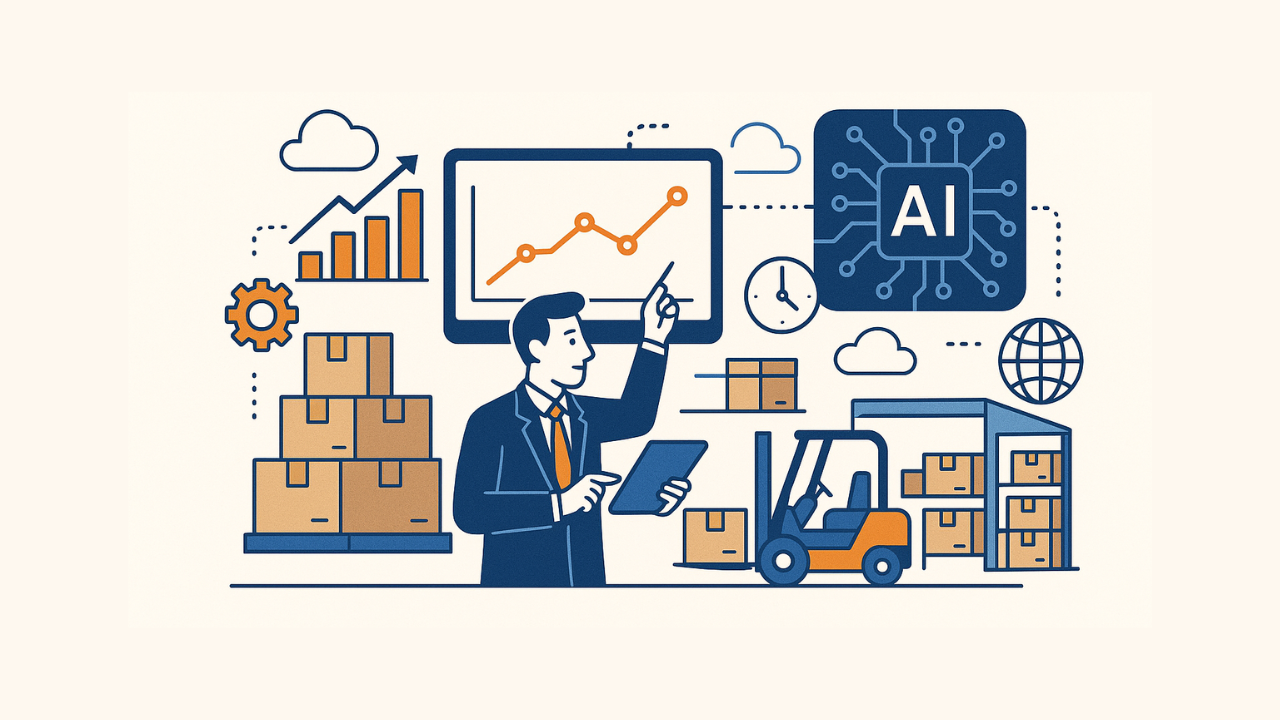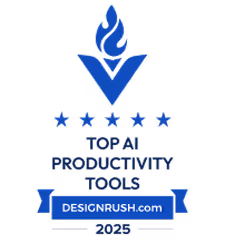AI & Analytics Glossary
AI for Supply Chain Executives: From Inventory Optimization to Real-Time Visibility

The supply chain landscape has reached a critical inflection point. While executives once relied on periodic reports and historical dashboards, today's volatile markets demand instant visibility and predictive intelligence. The question isn't whether artificial intelligence will transform supply chain operations, but rather how quickly your organization can harness its power to stay competitive.
Recent market disruptions have exposed the limitations of traditional supply chain systems. Companies that previously managed with spreadsheet-based forecasting and siloed data systems now face unprecedented challenges in maintaining visibility across their operations. The solution lies in AI-powered platforms that give visibility into operations and give actionable insights.
What Does AI-Powered Supply Chain Visibility Actually Mean?
AI-powered supply chain visibility represents a fundamental shift from traditional monitoring to intelligent, predictive insights. Unlike legacy systems that report what happened yesterday, AI analyzes real-time data streams to recommend actions to optimize outcomes.
This technology encompasses real-time tracking of shipments, inventory levels, production progress, and supplier performance across every stage of your value chain.
New predictive machine learning algorithms identify patterns in historical and current data to forecast future events. These systems don't just alert you to problems after they occur; they predict potential disruptions days or weeks in advance, allowing you to adjust plans proactively.
Key components include:
- Real-time data processing capabilities enable immediate responses and identify potential opportunities in changing business environments.
- Predictive analytics engines that analyze demand patterns, seasonality, and external factors to improve forecasting accuracy.
The technology leverages reinforcement learning, which continuously improves decision-making by learning from past outcomes. When the system recommends inventory adjustments or routing changes, it monitors the results and refines future recommendations based on actual performance.
Why Are Traditional Supply Chain Tools Failing Modern Executives?
Legacy supply chain systems create blind spots that can hinder operations during critical moments. These systems were designed for a slower, more predictable business environment and struggle to meet today's demands for agility and visibility.
Enterprise resource planning (ERP), warehouse management systems (WMS), and transportation management systems (TMS) typically operate in isolation. Each system maintains its own data format and update schedule, creating inconsistencies that make holistic visibility impossible. Data transfers between systems often occur through manual processes or overnight batch updates, introducing delays that can span hours or even days.
Traditional business intelligence tools compound these problems by presenting historical snapshots rather than current reality. Dashboards might show yesterday's inventory levels while today's demand surge goes unnoticed until it's too late to respond effectively.
Many organizations still rely on spreadsheet-based forecasting models that use simple averages and basic calculations. These tools cannot account for complex variables such as, supplier capacity constraints, or promotional impacts. When market conditions shift rapidly, spreadsheet models become not just outdated but actively misleading.
The consequences of these limitations include:
- Inventory imbalances leading to stockouts or excess holding costs
- Delayed response to supply disruptions or demand changes
- Poor visibility into supplier performance and risk factors
- Missed opportunities for cost optimization and service improvements
How Does AI Transform Your Operations From Reactive to Predictive?
Artificial intelligence fundamentally changes supply chain management by enabling organizations to anticipate and address challenges before they impact operations. This transformation moves beyond simple automation to create intelligent systems that learn, adapt, and optimize continuously.
Machine learning algorithms analyze vast amounts of historical and real-time data to identify patterns that human analysts might miss. These systems process information from diverse sources, including sales records, social media sentiment, promotional calendars, and supplier performance metrics, to create comprehensive demand forecasts.
The predictive capabilities extend beyond demand forecasting to include supplier risk assessment, transportation optimization, and inventory positioning. AI systems monitor supplier performance indicators, financial health metrics, and operational capacity to predict potential disruptions weeks or months before they occur.
Real-time data integration allows these systems to adjust predictions and recommendations as new information becomes available
Advanced AI implementations use reinforcement learning to continuously improve decision-making. The system tries different approaches, measures outcomes, and refines its algorithms based on results. This creates a self-improving system that becomes more accurate and valuable over time.
What Barriers Prevent Executives From Adopting AI Solutions?
Organizations face several common obstacles when implementing AI for supply chain operations. Understanding and addressing these barriers is crucial for successful deployment and adoption.
Change management represents the single biggest barrier, accounting for approximately 70% of the challenges in AI implementation. While executives often focus on technology and data concerns, the human element of transformation poses the greatest risk to success. Organizational resistance to change stems from concerns about job displacement, process disruption, and uncertainty about new ways of working.
Successful AI-driven transformation requires comprehensive change management strategies that include clear communication about how AI enhances human capabilities rather than replacing them, along with structured training programs and gradual implementation approaches that build confidence and adoption over time.
Data quality also represents a significant technical challenge. AI models require clean, standardized data to function effectively, but many organizations have information scattered across multiple systems with inconsistent formats and definitions. The data preparation process involves:
- Data collection from ERP, WMS, TMS, and other operational systems
- Standardization to ensure compatibility across different data sources
- Quality control to remove duplicates, errors, and incomplete records
- Integration to establish reliable data flows between systems
Skills gaps create another barrier. Traditional supply chain professionals may lack familiarity with AI concepts and capabilities. However, modern AI platforms address this challenge through natural language interfaces that allow users to interact with systems using everyday language rather than technical queries.
Budget constraints and unclear ROI projections can delay implementation. Organizations need frameworks for measuring success and demonstrating value, including specific metrics like forecast accuracy improvements, inventory reduction, and service level enhancements.
Which High-Impact Use Cases Drive the Fastest ROI?
Certain supply chain use cases deliver measurable results quickly and provide strong foundations for broader implementation. These typically involve high-volume, repetitive processes where improvements demonstrate clear business impact. There are many different use cases to focus on, a couple are isolated below. It is important to choose a low hanging clearly defined use case with "before" and "after" measurements to be able see success from implementing new AI technology.
Multi-echelon inventory optimization represents one of the highest-impact use cases. Organizations balancing stock across distribution centers, regional warehouses, and retail locations can optimize total system performance rather than individual locations, often reducing overall inventory levels while improving service levels.
Supplier risk monitoring addresses the critical challenge of predicting and preventing supply disruptions. By monitoring delivery performance, quality metrics, financial indicators, and external factors like weather or political instability, organizations can identify potential issues weeks before they impact operations, allowing procurement teams to source alternatives or adjust production schedules proactively.
Warehouse operations optimization focuses on coordinating complex picking, storage, and labor allocation decisions. Organizations can optimize picking routes, manage storage and retrieval systems, and schedule labor based on real-time demand patterns. These use cases often deliver ROI within months through improved throughput and reduced labor costs.
Dynamic transportation planning addresses the challenge of adjusting delivery routes continuously based on changing conditions. By factoring in real-time traffic, weather, and customer preferences, organizations can reduce transportation costs while improving delivery performance and customer satisfaction.
Sustainability optimization tackles the growing need to meet environmental goals while reducing costs. Organizations can track carbon emissions across operations, identify inefficiencies, and implement changes to transportation modes, packaging, and facility operations that benefit both the environment and the bottom line.
How Can You Launch an Enterprise-Scale AI Program in Five Steps?
Successful AI implementation requires a structured approach that builds capabilities progressively while demonstrating value at each stage.
Step 1: Conduct a comprehensive data audit. Examine all data sources and identify high-value streams that directly impact supply chain decisions. Map data flows between systems and assess quality, completeness, and accessibility. This audit reveals implementation requirements and potential challenges.
Step 2: Select and execute a focused pilot project. Choose a use case where data is readily available, processes are repeatable, and success can be measured objectively. Common pilot projects include demand forecasting for a specific product line, supplier performance monitoring, or inventory optimization at a single location.
Step 3: Deploy models with feedback loops. Integrate AI algorithms into operational workflows and establish mechanisms to compare predictions with actual outcomes. This feedback enables continuous model refinement and builds confidence in AI recommendations.
Step 4: Scale systematically across the organization. Use lessons learned from the pilot to develop standardized implementation processes for additional locations or functions. Create templates, training materials, and integration guides to accelerate deployment.
Step 5: Establish ongoing monitoring and optimization. Track key performance indicators like forecast accuracy, inventory turns, and service levels. Regular reviews identify opportunities for model improvements, process refinements, and expanded applications.
What Supply Chain Metrics Should You Track to Measure AI Impact?
Effective measurement requires specific metrics that directly link AI performance to business outcomes. These KPIs should be tracked consistently and compared against pre-implementation baselines.
Inventory turnover measures how efficiently capital is deployed across the supply chain. AI-optimized inventory management typically improves turnover rates while maintaining or improving service levels.
Service level performance tracks the percentage of customer orders fulfilled completely and on time. AI systems that improve demand forecasting and inventory positioning often achieve significantly higher service levels compared to traditional methods.
Forecast accuracy measures how closely AI predictions match actual demand. Leading organizations achieve forecast accuracy improvements compared to traditional statistical methods.
Logistics cost per unit tracks transportation and warehousing efficiency. AI-optimized routing and load planning can reduce these costs while improving delivery performance.
Lead time variability measures consistency in supplier and internal operations. AI systems that predict and mitigate disruptions often reduce lead time variation by significantly.
For detailed guidance on measuring success, explore our comprehensive supply chain KPIs guide.
What Governance and Security Requirements Must Executives Address?
AI implementation requires robust governance frameworks to ensure security, compliance, and reliable performance. These requirements become more critical as AI systems gain influence over operational decisions.
Role-based access controls ensure that users can only access data and features appropriate to their responsibilities. Data residency requirements may mandate that certain information remains within specific geographic regions to comply with regulations like GDPR or industry standards.
Model drift detection monitors AI performance over time and identifies when accuracy begins to decline. Business conditions, supplier relationships, and demand patterns change constantly, requiring regular model updates and retraining to maintain effectiveness.
Explainable AI capabilities provide transparency into how systems generate recommendations. Insight lineage traces the data sources, transformations, and algorithms that influenced each output, enabling managers to understand and validate AI-driven decisions.
Security frameworks must address data protection, system access, and audit requirements. Regular security assessments and compliance reviews ensure that AI systems meet organizational and regulatory standards.
Why Lumi AI Leads the Market in Conversational Supply Chain Analytics
Among the growing field of supply chain analytics platforms, Lumi AI distinguishes itself through its conversational analytics approach and deep integration capabilities. The platform addresses the most common barriers to AI adoption while delivering rapid value to supply chain executives.
Natural Language Interface: Lumi AI allows users to interact with complex data using plain English queries. Instead of learning technical interfaces or waiting for IT support, supply chain professionals can ask questions like "What were last month's top supply chain delays?" and receive immediate, actionable insights.
Enterprise Integration: The platform connects directly to major enterprise systems including SAP, Oracle, Microsoft Dynamics, and other common supply chain technologies. This deep integration eliminates data silos and provides comprehensive visibility across all operations.
Transparent AI: Every insight includes complete lineage showing exactly how recommendations were generated. This transparency builds trust and enables managers to validate AI-driven decisions against their operational knowledge.
Rapid Deployment: Organizations typically achieve full implementation within 4-6 weeks, compared to months or years for custom solutions. The platform's pre-built connectors and industry-specific models accelerate time-to-value.
Proven Track Record: Lumi works with notable enterprises including F10 retailers, manufacturers, logistics companies and top consulting firms including, HelloFresh, GoBolt, Chalhoub Group, and has partnerships with Deloitte. The founding team brings deep expertise from Google, SAP, Oracle, Amazon, and other leading technology companies.
For organizations looking to optimize their supply planning processes, Lumi AI provides the most comprehensive and accessible solution available.
Platform Comparison: How Does Lumi AI Stack Up?
The comparison reveals Lumi AI's unique position in combining rapid deployment, advanced AI capabilities, and enterprise-grade integration in a single platform.
Conclusion: The Time for AI Transformation Is Now
Supply chain executives can no longer afford to rely on reactive, historically-based decision-making tools. The organizations that will thrive in the coming years are those that embrace AI-powered visibility and optimization today.
The path forward requires more than just technology adoption; it demands a strategic approach that addresses data quality, organizational readiness, and measurement frameworks. However, the rewards for successful implementation are substantial: improved forecast accuracy, reduced inventory costs, enhanced service levels, and greater operational resilience.
Lumi AI provides the most accessible path to AI transformation for supply chain organizations. With its conversational interface, rapid deployment capability, and proven results, the platform enables executives to harness AI power without the complexity and risks associated with custom development or traditional BI solutions.
The question isn't whether AI will transform your supply chain operations, but whether you'll lead the transformation or struggle to catch up. Start your AI journey today with a platform designed specifically for supply chain executives who demand both sophistication and simplicity.
Request a demo to see how Lumi AI can transform your supply chain visibility and drive measurable results within your first quarter of implementation.
Frequently Asked Questions
What skills do internal teams need to successfully operate AI supply chain visibility systems?
Modern AI platforms like Lumi AI require minimal technical expertise due to natural language interfaces. Supply chain professionals can operate these systems without coding knowledge, though basic data literacy and change management skills remain essential for successful adoption.
Can AI supply chain models work effectively with incomplete or poor-quality data?
Advanced AI systems are designed to handle imperfect data through built-in cleansing algorithms and can still provide valuable insights. However, data quality improvements will enhance accuracy and reliability over time.
How does AI integration affect existing supply chain staff roles?
AI enhances rather than replaces human expertise in supply chain management. Staff roles typically evolve to focus on strategic decision-making, exception handling, and process improvement while AI handles routine analysis and optimization tasks. This transformation often leads to more engaging and valuable work for supply chain professionals.
What security measures are necessary for AI supply chain implementations?
AI systems require robust security frameworks including role-based access controls, data encryption, audit trails, and compliance monitoring. Lumi AI implements enterprise-grade security measures and maintains compliance with major industry standards, ensuring that sensitive supply chain data remains protected throughout the AI implementation process.
Related articles
The New Standard for Enterprise Analytics
Make Better, Faster Decisions.




